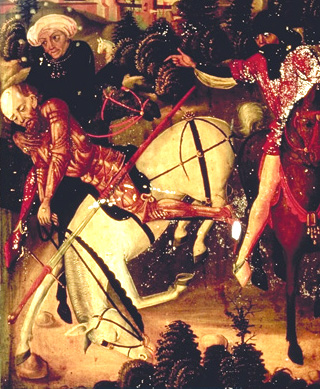This image also is of interest to me because it depicts both blackened/blued armour and bright steel (the sword blade). It can be hard to judge armour color in medieval artwork because oftentimes the armour and arms are the same color--blue/black--suggesting tarnished silver rather than the artist's original color choice. There doesn't seem to be much doubt here that the artist is depicting dark armour.
Bekehrung des Hl. Paulus
Dieses Bild: 011691
Kunstwerk: Temperamalerei-Holz ; Einrichtung sakral ; Flügelaltar Peter und Paul-Altar ; Slowakei ; Apg:09:001-008
Dokumentation: 1490 ; 1500 ; Levoca ; Slowakei ; Pfarrkirche St. Jakob
Anmerkungen: 930x485 ; Levoca ; Libuse Cidlinska,Goticke kridlove oltare na Slovensku, 1989, S. 48f
